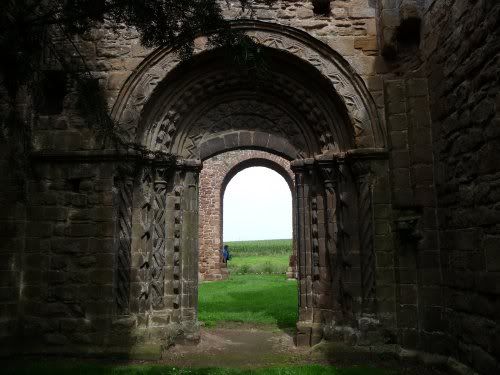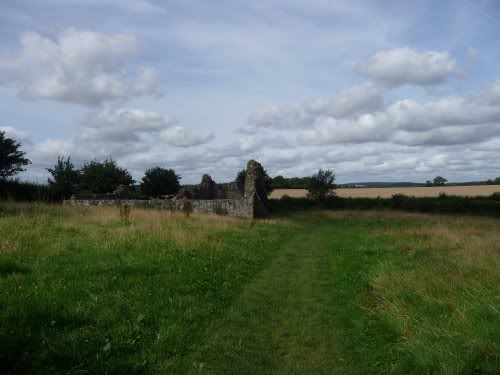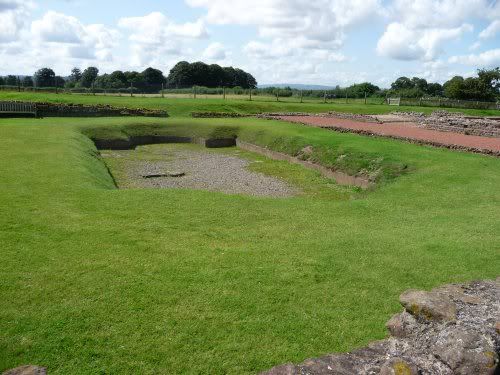Shropshire hols
I felt very much like The Good Housewife this morning as I got up just before 7am and made curry for tonight.
As I've been busy these last few days, here's a somewhat belated bunch of pics from last week's hols. LOL of the trip was going to the local pub one evening for a meal. At about 7pm there was a bit of a racket outside that sounded like those really huge three-wheeler motorbike things backfiring. When we came out of the pub later, there was a helicopter on the lawn beside the car park. Yes, a HELICOPTER. A small one, but nevertheless, a helicopter.
Apparently Helicopter Dude lives in Oswestry, which is about 35 miles from Much Wenlock. Granted, the roads are narrow and slow, but still, normal people would take the car.
Buildwas Abbey
A Cistercian abbey near Ironbridge, founded in 1135 and dissolved in 1536. It's so close to the border that the abbey was raided on several occasions by the marauding Welsh (we do the marauding thing quite well). The high point in its history came in 1342 when one of the monks killed the abbot. Must have been the food.

Church nave, looking west.

The crypt, now a storeroom for bits of random ecclesiastical masonry.

Buildwas has a lovely intact chapter house with a good portion of its floor tiles still in situ.
Haughmond Abbey
One of my very favourite abbeys, Haughmond's chief claim to fame is the role it played in the Battle of Shrewsbury (1403) between Henry IV and Harry Hotspur. The king lodged at the abbey overnight before taking to the field, and the abbot, along with the abbot of Shrewsbury, spent most of the day trying to broker peace between the opposing armies. The battle was one of those great defining moments in English history and showed the might of the longbow archers - Henry IV very nearly lost his crown, and the prince (Henry V) got his famous scar at Shrewsbury. The events of the battle appear in Henry IV, Part 1.
Founded in 1100, the abbey was Augustinian. It was dissolved in 1539.

Haughmond is famous for its elaborate decoration on the chapter house. The figures of St Augustine, St Thomas a Becket, St Winifred and several others are carved between the pillars.

Inside the chapter house.

Front parlour windows of the abbot's house. Haughmond was a very rich abbey!

Looking across the refectory (upper part) with the undercroft below.
Lilleshall
A small Augustinian abbey founded in 1138 and dissolved in 1538, by which time it was heavily in debt.

West door, church nave looking east.

Part of the cloister is still intact. Book room and chapter house.

The door into the church has some lovely decoration.
Much Wenlock
The small market town of Much Wenlock grew up around the monastery established in the 7th century. The priory ruins that remain today (which we visited earlier in the year) are of later date, and the nicest of the town buildings are Tudor.

Ashfield Hall, originally a Hospitaller lodge/hospital.

The Guild Hall - still used today for council meetings and as a farmer's market. This building dates from 1540, though the hall has stood here since the 13th century.

Holy Trinity church, a fairly standard Norman effort, but unusually the priest's house survives (you can see it above the south door - the priest lived above the porch and had a spiral staircase leading out by the tower).

We had a moment of LOL on spotting this cannabis seat-runner in the church!!

A good example of Tudor buildings in the centre of town.

The view from the guesthouse patio. We stayed on a farm in the middle of nowhere, just to one side of Wenlock Edge. The hill in the background is the Wrekin - Midlanders have the saying "All around the Wrekin", which means going out of one's way to do something. I say it a lot.
Stokesay Castle
A real hidden gem, Stokesay Castle is actually a fortified manor house - the oldest in England and certainly the best preserved, mainly due to the fact that the only time it faced a marauding army in the Civil War, it surrendered. Built in the 1280s by a massively rich wool merchant from Ludlow, it was granted its licence to crenellate in 1291 (which technically raises it to castle status).

Stokesay Castle from the south. It has a moat and everything!

The gatehouse is Jacobean (late 16th century)...

...and is covered in these exquisite timber carvings. This is a Green Man, ancient pagan symbol of nature.

View of the castle courtyard from halfway up the tower.

The solar contains this elaborate Elizabethan fireplace.

The main hall, with rather rickety access at the back to the main bedchamber.

Swallows, swifts and house martens have made their nests in various parts of the castle. Here's a swallow waiting for us to leave the tower so it can feed its young.

The tower and part of the main hall.
White Ladies Priory & Boscobel House
The convent is famous for being the first resting-place of the future king Charles II following the Battle of Worcester (1651). Though dissolved in 1535, the priory passed into the hands of a local landowner, who used the area as a hunting ground. The servants - five brothers - who took care of the grounds, including the priory ruins and the nearby hunting lodge of Boscobel House, were Royalist sympathisers who sheltered Charles. One of the brothers was to lead Charles through the Midlands to safety, and when Charles was restored to the throne, he granted the brothers and their families an annual pension in perpetuity. The descendants of the brothers still receive this pension from the Crown today.

The remains of White Ladies Priory.

Door into the priory church.

Looking east across the priory ruins.
We didn't get any pics of Boscobel House as outwardly it's not that interesting - Tudor original bricked over in the 18th century and 'restored' by the Victorians. However...

This is the Royal Oak, the second-generation descendent of the tree Charles hid in during his flight from Worcester (in 1651 the area was heavily wooded!). Charles was on the run for a couple of weeks, but Boscobel was the closest the Roundheads ever came to capturing him. He eventually made it into exile in France, where he remained until the English got bored with being a republic.
Wroxeter (Viroconium Cornoviorum)
Established in 58AD as a legionary fortress (XIV legion Gemina) during the invasion of Wales, it was abandoned by the military in 88AD and became a civilian settlement. When the Romans left in the early 5th century, the city became the residence of a British tribal leader. Excavations began in the 19th century, when the site became the first archaeological tourist attraction in England.

'The Old Work' - the large wall in the background - formed part of the wall of the immense bath-house bordering one side of the palaestra (exercise ground). View looking from the centre of the baths complex with its restored hypocaust system.

All Roman fortresses and towns follow the same design, regardless of location. This is the outdoor pool in the courtyard of the bath-house. Unsurprisingly, given the vagaries of the British climate, it was filled in not long after its construction.

The frontage of the bath-house was occupied by shops, which opened onto the main road through the settlement. Here you can see the outlines of the shops, with the bath-house courtyard behind.
Work
I sent in an RFC this week and have another two possibles to make a decision on next week. The tech person found that a whole bunch of subs had got caught in some filter or other, so I now have 10 subs to sort through. Fortunately I can junk at least half of those as unsuitable (someone sent in poetry. We don't publish poetry. Amazing how many people don't pay attention to the guidelines).
F1 Fic o'Doom

Observe the new estimated wordcount. I've finished 3 chapters out of 28. Yargh. Michael's feeble attempt at a comeback has only changed sub-plot A. I am beginning to find Martin Whitmarsh (sub-plot B) strangely likeable.
Meme time! Nicked from everyone else.
Ask me my fannish Top Five [whatevers]. Any top fives. Doesn't matter what, really! And I will answer them all in a new post.
As I've been busy these last few days, here's a somewhat belated bunch of pics from last week's hols. LOL of the trip was going to the local pub one evening for a meal. At about 7pm there was a bit of a racket outside that sounded like those really huge three-wheeler motorbike things backfiring. When we came out of the pub later, there was a helicopter on the lawn beside the car park. Yes, a HELICOPTER. A small one, but nevertheless, a helicopter.
Apparently Helicopter Dude lives in Oswestry, which is about 35 miles from Much Wenlock. Granted, the roads are narrow and slow, but still, normal people would take the car.
Buildwas Abbey
A Cistercian abbey near Ironbridge, founded in 1135 and dissolved in 1536. It's so close to the border that the abbey was raided on several occasions by the marauding Welsh (we do the marauding thing quite well). The high point in its history came in 1342 when one of the monks killed the abbot. Must have been the food.

Church nave, looking west.

The crypt, now a storeroom for bits of random ecclesiastical masonry.

Buildwas has a lovely intact chapter house with a good portion of its floor tiles still in situ.
Haughmond Abbey
One of my very favourite abbeys, Haughmond's chief claim to fame is the role it played in the Battle of Shrewsbury (1403) between Henry IV and Harry Hotspur. The king lodged at the abbey overnight before taking to the field, and the abbot, along with the abbot of Shrewsbury, spent most of the day trying to broker peace between the opposing armies. The battle was one of those great defining moments in English history and showed the might of the longbow archers - Henry IV very nearly lost his crown, and the prince (Henry V) got his famous scar at Shrewsbury. The events of the battle appear in Henry IV, Part 1.
Founded in 1100, the abbey was Augustinian. It was dissolved in 1539.

Haughmond is famous for its elaborate decoration on the chapter house. The figures of St Augustine, St Thomas a Becket, St Winifred and several others are carved between the pillars.

Inside the chapter house.

Front parlour windows of the abbot's house. Haughmond was a very rich abbey!

Looking across the refectory (upper part) with the undercroft below.
Lilleshall
A small Augustinian abbey founded in 1138 and dissolved in 1538, by which time it was heavily in debt.

West door, church nave looking east.

Part of the cloister is still intact. Book room and chapter house.

The door into the church has some lovely decoration.
Much Wenlock
The small market town of Much Wenlock grew up around the monastery established in the 7th century. The priory ruins that remain today (which we visited earlier in the year) are of later date, and the nicest of the town buildings are Tudor.

Ashfield Hall, originally a Hospitaller lodge/hospital.

The Guild Hall - still used today for council meetings and as a farmer's market. This building dates from 1540, though the hall has stood here since the 13th century.

Holy Trinity church, a fairly standard Norman effort, but unusually the priest's house survives (you can see it above the south door - the priest lived above the porch and had a spiral staircase leading out by the tower).

We had a moment of LOL on spotting this cannabis seat-runner in the church!!

A good example of Tudor buildings in the centre of town.

The view from the guesthouse patio. We stayed on a farm in the middle of nowhere, just to one side of Wenlock Edge. The hill in the background is the Wrekin - Midlanders have the saying "All around the Wrekin", which means going out of one's way to do something. I say it a lot.
Stokesay Castle
A real hidden gem, Stokesay Castle is actually a fortified manor house - the oldest in England and certainly the best preserved, mainly due to the fact that the only time it faced a marauding army in the Civil War, it surrendered. Built in the 1280s by a massively rich wool merchant from Ludlow, it was granted its licence to crenellate in 1291 (which technically raises it to castle status).

Stokesay Castle from the south. It has a moat and everything!

The gatehouse is Jacobean (late 16th century)...

...and is covered in these exquisite timber carvings. This is a Green Man, ancient pagan symbol of nature.

View of the castle courtyard from halfway up the tower.

The solar contains this elaborate Elizabethan fireplace.

The main hall, with rather rickety access at the back to the main bedchamber.

Swallows, swifts and house martens have made their nests in various parts of the castle. Here's a swallow waiting for us to leave the tower so it can feed its young.

The tower and part of the main hall.
White Ladies Priory & Boscobel House
The convent is famous for being the first resting-place of the future king Charles II following the Battle of Worcester (1651). Though dissolved in 1535, the priory passed into the hands of a local landowner, who used the area as a hunting ground. The servants - five brothers - who took care of the grounds, including the priory ruins and the nearby hunting lodge of Boscobel House, were Royalist sympathisers who sheltered Charles. One of the brothers was to lead Charles through the Midlands to safety, and when Charles was restored to the throne, he granted the brothers and their families an annual pension in perpetuity. The descendants of the brothers still receive this pension from the Crown today.

The remains of White Ladies Priory.

Door into the priory church.

Looking east across the priory ruins.
We didn't get any pics of Boscobel House as outwardly it's not that interesting - Tudor original bricked over in the 18th century and 'restored' by the Victorians. However...

This is the Royal Oak, the second-generation descendent of the tree Charles hid in during his flight from Worcester (in 1651 the area was heavily wooded!). Charles was on the run for a couple of weeks, but Boscobel was the closest the Roundheads ever came to capturing him. He eventually made it into exile in France, where he remained until the English got bored with being a republic.
Wroxeter (Viroconium Cornoviorum)
Established in 58AD as a legionary fortress (XIV legion Gemina) during the invasion of Wales, it was abandoned by the military in 88AD and became a civilian settlement. When the Romans left in the early 5th century, the city became the residence of a British tribal leader. Excavations began in the 19th century, when the site became the first archaeological tourist attraction in England.

'The Old Work' - the large wall in the background - formed part of the wall of the immense bath-house bordering one side of the palaestra (exercise ground). View looking from the centre of the baths complex with its restored hypocaust system.

All Roman fortresses and towns follow the same design, regardless of location. This is the outdoor pool in the courtyard of the bath-house. Unsurprisingly, given the vagaries of the British climate, it was filled in not long after its construction.

The frontage of the bath-house was occupied by shops, which opened onto the main road through the settlement. Here you can see the outlines of the shops, with the bath-house courtyard behind.
Work
I sent in an RFC this week and have another two possibles to make a decision on next week. The tech person found that a whole bunch of subs had got caught in some filter or other, so I now have 10 subs to sort through. Fortunately I can junk at least half of those as unsuitable (someone sent in poetry. We don't publish poetry. Amazing how many people don't pay attention to the guidelines).
F1 Fic o'Doom
Observe the new estimated wordcount. I've finished 3 chapters out of 28. Yargh. Michael's feeble attempt at a comeback has only changed sub-plot A. I am beginning to find Martin Whitmarsh (sub-plot B) strangely likeable.
Meme time! Nicked from everyone else.
Ask me my fannish Top Five [whatevers]. Any top fives. Doesn't matter what, really! And I will answer them all in a new post.